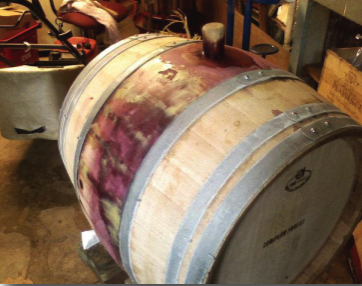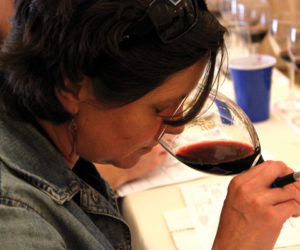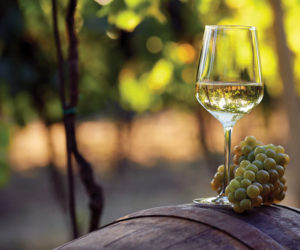Q
I recently purchased a new 32-gallon (121-L) wine barrel made of Hungarian oak from the Zemplen forest. I should let you know that I have been making wine, one of which won a Silver Medal in the WineMaker Amateur Wine Competition, for over 30 years. I have used French and American Oak before but this is the first time for Hungarian. I treated the barrel properly as per instruction, and then put my wine in it. To my surprise, the wine started to seep, not from between the staves or the barrel heads but through the staves themselves. The seepage was fairly wide spread affecting about half of the belly. I was told that wood from the Zemplen forest was so dense that in fact you need to keep wine in barrel for 14 months or so. I seem to have halted the seepage by using wax but now I am wondering about the state of my wine. Is there anything I should be worried about or any additional measures I should take to protect the wine? Have you heard of this happening before?
Eric Weinstein
Maine
A
I’ve certainly had the odd leaker (or three) but I’ve never experienced trans-stave leakage of the scale that you describe. Before I delve any deeper, I first of all would like to say that your situation is unusual and one that warrants an immediate customer service call (read: complaint) to your barrel supplier. It is normal for barrels to need a little soaking up with water before they can be filled with wine. Sometimes we even need to go beyond the “instructions” and use hot water on the barrel head or something like that to properly swell up a barrel. Your type and scale of leakage, however, goes far beyond what is normal and in fact travels headlong into “product defect” category. Any self-respecting barrel supplier should show you the proper concern and offer to exchange your product.
Let me describe why I believe your situation goes quite beyond the expected “new barrel” seeps and leaks most of us are used to. Oak barrels (and barrels made of other woods, sometimes acacia wood or even cherry wood) are really structurally amazing. I liken a well-built barrel to a lovely piece of furniture. Just like a well-built chest of drawers with hand-cut dovetail joints, a correctly-made barrel is an exercise in close-fitting wood pieces held together by pressure and a little hardware (the metal hoops, to a cabinet’s finishing nails). The species of oak used in France, Hungary and the US for cooperage are all nice and hard (they can hold water) but are still also “soft” enough to be bent with heat and steam as they are in barrel making. As we all know, wood is a natural product and can lose moisture over time, drying up and shrinking. This is why introducing steam or water into the barrel is often necessary (“swelling up the wood”) before a new barrel is ready to store wine. It’s also just smart to rinse water around in your new barrel to check it for leaks, just to make sure you know what to expect.
A barrel is made up of exactly-cut staves (the long wood pieces) and two round barrel heads held together by the pressure exerted on them by the hoops, which are gently pounded on to hold all the pieces together. The stavewood in turn is cut from sections of a tree. Oak trees have almost-microscopic tubes called xylem and phloem running vertically up and down them. These tubes are essentially the tree’s veins, and carry the tree’s lifeblood (carbohydrates, minerals, water, etc) to all parts of the plants. When a tree grows straight up and down, these little tubes run straight up and down too. When a stave is shaped from a straight tree, the tubes generally run lengthwise up and down the stave as well. If you look closely, you can see evidence of this “grain” and tubular material at the end of each stave by the barrel head. Straight-growing trees are best for barrel-making because the little tubes, for the most part, run along the whole length of the stave, parallel to the wine inside, not presenting many open channels through which wine can travel through the stave to the surface. This way, the only leak points are the small spaces between the staves themselves, not within the wood of each stave. These between-stave leak points are what we normally swell up when we “soak up” a barrel.
If, however, an oak tree grows crooked, the little tubes grow crooked too, and a stave cut from a crooked tree will have the little tubes going all over the place, undulating back and forth through the “straight” stave that has been cut from the crooked wood. This means that there is a greater chance of ends of these tubes being shaved off and exposed on the outside (and inside) surface of the stave as it is cut and shaped. Now there exist channels through which wine can migrate after filling, from whence come horror stories like yours where the staves themselves are leaking wine through them. Most barrels will have some “open” xylem or phloem because the staves are always planed towards the end as the chime (the end of each stave where it attaches to the barrel head) is shaped. In properly made barrels, these few holes will close up easily with the “soak up” we’ve discussed. However, in a bad case like yours, a fatally high number of trans-stave channels are present and the entire barrel’s integrity is compromised. In short, you’ve just put your wine into a leaky sieve. (It’s either that or you have a well-hidden internal crack that goes across a few staves, which could be caused by a dropped barrel, but I believe it’s the former.)
What to do? Get your wine out of the barrel as soon as you can and get your barrel supplier on the horn. I’ve had to get pretty aggressive on barrel-soaking once or twice over the years. With small barrels like yours, I’ve sometimes had to completely submerge them in a half-ton picking bin or plastic garbage can full of water and leave them there for 48 hours to get the kind of soak I needed. Sometimes I’ll have a little wine seepage that corrects itself after 12 hours or so. If, however, after 48 hours of complete soaking I still have a big leak (and not a teeny seep), that barrel has a problem and your supplier needs to do something about it. Here in Napa, if I have an issue, my cooper will make “cellar calls” and sometimes will help me plug up a little leak with some paraffin, or may even refit a head if need be. However, I can tell you, that my salespeople would never let me suffer through as much trans-stave leakage as you are describing. Bad wood makes bad barrels and bad barrels make bad wine. Barrels cost a lot of money. Don’t put up with it.
Q
I harvested my first crop of Chardonel and Norton this year. Both had pH in the 4.0-4.24 range with total acidity (TA) around 8. After malolactic fermentation, my TAs were around 7, but the pH still stayed high. I’ve heavily sulfited to protect the wine, but I’m curious if you feel I should lower the pH prior to aging by adding tartaric acid, or just follow my SO2 and maybe adjust after six to nine months?
Dave Rearick
Roswell, Georgia
A
Absolutely, I would lower your pH prior to aging. No matter how high the TA is, if you’ve got a high pH as well, you are putting your wines at risk for premature oxidation and, most critically, are providing an environment that favors the growth of spoilage organisms. Bacteria enjoy higher pH environments, even with a relatively high TA.
Exactly how much acid you will have to add is difficult to calculate because it depends on the buffering capacity of each individual wine. I would recommend adding 1 g/L, re-measuring your pH then re-tasting and adding more as you like, doing it incrementally — maybe at 0.3 g/L after that, or after seeing what 1 g/L got you. You want to get the acid reading into a safer range, but you certainly don’t want to overshoot. I would aim to get your pH down to at least 3.75 because at higher pHs, SO2 additions are less effective against microbes and oxidation.
Q
I have tried several of the new chocolate wines and I love them. I have tried with little success to make chocolate wine with my wine club friends. I have bought several books on winemaking, but cannot find a recipe for chocolate wine. Can you please help?
Jerry
Transfer, Pennsylvania
A
So you want to put some chocolate flavor, texture and aroma into your wines, eh? My approach would definitely be to use the chocolate grace-notes as an ending treatment to your wine, as opposed to a fermentative one. This is how a “friend of a friend” of mine made something similar; they trialed in additives into finished wine, then gave the concoction a sterile filtration before bottling. Cocoa beans, chocolate syrups, baking chocolate etc all contain quite a bit of fat, which does not do well in a fermentation (yeast can’t use it, it can go rancid, etc.). Cocoa beans, chocolate and even cocoa powder all have a very high pH, of 7–9, which means that you’d be throwing off the acid balance of your fermenter as well, which is not great for a healthy yeast population. Needless to say, I think you should take a good, sound base wine (maybe laced with a little brandy for body and stability) and then trial in your flavoring agents and additives.
And what are those flavoring agents and additives? Well, all “chocolate wines” I’m aware of are sweet, fruity, somewhat creamy and definitely boozy. Almost like a sweet, wine-based cocktail or something like a lesser-octane Bailey’s Irish Cream. What’s cool is that you can actually make an Irish Cream type liqueur at home. You simply stir together whiskey, chocolate syrup, sweetened condensed milk, vanilla, almond extract, ground coffee crystals, seal up in a bottle and store in your refrigerator. Some recipes call for cooking the ingredients, but heat may change the flavor. I imagine that making a chocolate-flavored beverage would be similarly involved.
To get you started experimenting in the kitchen on a small scale, I’ve outlined below some ingredient possibilities. Just like with any good cocktail (or wine for that matter), you want your tipple to be balanced, approachable, flavorful and to have a nice body and mouthfeel. I would start with your base (or combination of base, add some sweetness, then layer in the chocolate and extra “complexing” agents in small doses. I’ve skewed my list towards ingredients that have a decent chance of remaining dissolved in an acidic, alcoholic solution and won’t separate in the bottle. The dairy ingredients might be a different story because of their fat and protein contents. I recommend using them in small amounts only.
Possible base ingredients:
• A big red wine, like a Zinfandel
• A Port-type wine
• Brandy
“Chocolate” flavor ingredients:
• Chocolate-flavored syrup for Italian sodas, like the kind sold by Torani (no dairy ingredients)
• Chocolate extract (an alcohol-based extract much like the vanilla extract used in baking. No dairy to precipitate out)
• Chocolate syrup like Hershey’s
Extra “complexing” ingredients:
• Vanilla extract
• Almond extract
• Raspberry liqueur
• Espresso
• Instant coffee crystals
Sweetening ingredients:
• Table sugar
• Sugar substitute of your choice (stevia, Sucralose, etc)
Creamy Components:
• Half and half
• Sweetened condensed milk
If you find a recipe of proportions that you like, try making up a couple of small sample bottles (I love little glass 187-mL screwcap sample bottles for this) and letting them sit for anywhere from a few days into a few weeks, tasting and evaluating one occasionally. This will give you an idea of shelf stability, aging potential and how those new and wacky flavors get together in the glass and marry (or divorce?) over time. Since you will be in pretty uncharted territory, keeping good notes and making objective (Did the layers separate? Is there a ton of sediment? Did it re-ferment?) and subjective (How does it taste? What are the aromas like?) observations will be a must.
Depending on the cocktail you come up with, you might have a pretty shelf-stable product or you might have something that won’t keep longer than a few days. Don’t forget some wine and food chemistry basics as you think about recipe development. High alcohol, high acid, high tannin all help keep oxidation and microbial activity at bay. One of your biggest dangers will be re-fermentation of the added sugars, so you will want to try and sterile filter your product unless your alcohol is over 17% or so, where it should act as enough of a deterrent.
So what would I do for a recipe? I would start with something like this (to make 1 L), evaluate bench trials and go from there:
Ingredients
• 2 tsp. vanilla extract
• 1⁄4 tsp. almond extract
• 2 Tb. instant espresso granules
• 1 Tb. chocolate extract (alcohol-based baking/candy making extract)
• 200 mL Torani Chocolate Milano Syrup (or similar dark chocolate dairy-free syrup)
• 75 mL sweetened condensed milk
• 150 mL brandy
• Top up to 1 L with a high-alcohol big, rich Zinfandel or other tannic red wine.
Step by Step
Stir all ingredients together until dissolved and decant into small sample bottles to evaluate for refermentation, precipitation, and aroma and flavor development over time. Try adding a pinch or two of tartaric acid powder to see if that helps balance the flavor. Watch for the dairy precipitation and see if you like it without the condensed milk. If it’s not sweet enough, add more syrup or table sugar. Up the alcohol if you get a refermentation. Don’t forget to sterile filter (if it’s not too thick) if you scale it up to cellar-scale and take it beyond a kitchen project.







